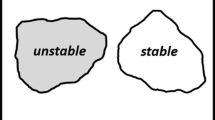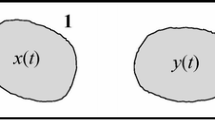Abstract
A fault with two asperities with different areas and strengths is considered. The fault is treated as a dynamical system with two state variables (the slip deficits of the asperities) and four dynamic modes, for which complete analytical solutions are provided. The seismic events generated by the fault can be discriminated in terms of a variable related with the difference between the slip deficits of the asperities at the beginning of the interseismic interval preceding the event. The effect of the difference between the asperity areas on several features of the model, such as the force rates on the asperities, the slip duration and amplitude, the occurrence of events involving the simultaneous motion of the asperities and the radiation of elastic waves, is discussed. As an application, the \(M_w\) 8.0 2007 Pisco, Peru, earthquake is considered: it is modelled as a two-mode event due to the consecutive failure of two asperities, one almost twice as large as the other. The source function and final seismic moment predicted by the model are found to be in good agreement with observations.










Similar content being viewed by others
References
Amendola A, Dragoni M (2013) Dynamics of a two-fault system with viscoelastic coupling. Nonlinear Processes Geophys 20:1–10. https://doi.org/10.5194/npg-20-1-2013
Chen T, Lapusta N (2009) Scaling of small repeating earthquakes explained by interaction of seismic and aseismic slip in a rate and state fault model. J Geophys Res 114:B01311. https://doi.org/10.1029/2008JB005749
Di Bernardo M, Budd CJ, Champneys AR, Kowalczyk P (2008) Piecewise-smooth dynamical systems-theory and applications. Springer, Berlin
Dragoni M, Lorenzano E (2015) Stress states and moment rates of a two-asperity fault in the presence of viscoelastic relaxation. Nonlinear Processes Geophys 22:349–359. https://doi.org/10.5194/npg-22-349-2015
Dragoni M, Lorenzano E (2017) Dynamics of a fault model with two mechanically different regions. Earth Planets Sp 69:145. https://doi.org/10.1186/s40623-017-0731-2
Dragoni M, Piombo A (2015) Effect of stress perturbations on the dynamics of a complex fault. Pure Appl Geophys 172(10):2571–2583. https://doi.org/10.1007/s00024-015-1046-5
Dragoni M, Santini S (2012) Long-term dynamics of a fault with two asperities of different strengths. Geophys J Int 191:1457–1467. https://doi.org/10.1111/j.1365-246X.2012.05701.x
Dragoni M, Santini S (2014) Source functions of a two-asperity fault model. Geophys J Int 196:1803–1812. https://doi.org/10.1093/gji/ggt491
Dragoni M, Santini S (2015) A two-asperity fault model with wave radiation. Phys Earth Planet Inter 248:83–93
Dragoni M, Tallarico A (2016) Complex events in a fault model with interacting asperities. Phys Earth Planet Inter 257:115–127
Huang J, Turcotte DL (1990) Are earthquakes an example of deterministic chaos? Geophys Res Lett 17:223–226
Jaeger JC, Cook NGW (1976) Fundamentals of rock mechanics. Chapman & Hall, London
Lay T, Kanamori H, Ruff L (1982) The asperity model and the nature of large subduction zone earthquakes. Earthq Pred Res 1:3–71
Lay T, Ammon CJ, Hutko AR, Kanamori H (2010) Effects of kinematic constraints on teleseismic finite-source rupture inversions: great Peruvian earthquakes of 23 June 2001 and 15 August 2007. Bull Seismol Soc Am 100(3):969–994
Luo Y, Ampuero JP (2017) Stability of faults with heterogeneous friction properties and effective normal stress. Tectonophysics. https://doi.org/10.1016/j.tecto.2017.11.006
McCloskey J, Bean CJ (1992) Time and magnitude predictions in shocks due to chaotic fault interactions. Geophys Res Lett 19:119–122
Nussbaum J, Ruina A (1987) A two degree-of-freedom earthquake model with static/dynamic friction. Pure Appl Geophys 125:629–656
Rice JR (1993) Spatio-temporal complexity of slip on a fault. J Geophys Res 98:9885–9907
Ruff LJ (1983) Fault asperities inferred from seismic body waves. In: Kanamori H, Boschi E (eds) Earthquakes: observation, theory and interpretation. North-Holland, Amsterdam, pp 251–276
Ruff LJ (1992) Asperity distributions and large earthquake occurrence in subduction zones. Tectonophysics 211:61–83
Scholz CH (1990) The mechanics of earthquakes and faulting. Cambridge University Press, Cambridge
Skarbek RM, Rempel AW, Schmidt DA (2012) Geologic heterogeneity can produce aseismic slip transients. Geophys Res Lett. https://doi.org/10.1029/2012GL053762
Sladen A, Tavera H, Simons M, Avouac JP, Konca AO, Perfettini H, Audin L, Fielding EJ, Ortega F, Cavagnoud R (2010) Source model of the 2007 Mw 8.0 Pisco, Peru earthquake: implications for seismogenic behavior of subduction megathrusts. J Geophys Res 115(B2):2156–2202. https://doi.org/10.1029/2009JB006429
Turcotte DL (1997) Fractals and chaos in geology and geophysics, 2nd edn. Cambridge University Press, Cambridge
Acknowledgements
The authors are thankful to the editor Roussos Dimitrakopoulos and to two anonymous referees for their useful comments on the first version of the paper.
Author information
Authors and Affiliations
Corresponding author
Constants in the Solution for Mode 11
Constants in the Solution for Mode 11
1.1 Case \(10 \rightarrow 11\)
The initial conditions are
where \({\bar{X}}\) and \({\bar{Y}}\) are the slip deficits of asperities 1 and 2, respectively, when the asperities start slipping together. Asperity 1, which was already slipping at the onset of mode 11, is associated with a certain rate \({\bar{V}}\), whereas asperity 2 is initially stationary. The slip deficits \({\bar{X}}\) and \({\bar{Y}}\) satisfy the Eq. (24) of Line 2. The constants are
1.2 Case \(01 \rightarrow 11\)
The initial conditions are
where \({\bar{X}}\) and \({\bar{Y}}\) are the slip deficits of asperities 1 and 2, respectively, when the asperities start slipping together. Asperity 2, which was already slipping at the onset of mode 11, is associated with a certain rate \({\bar{V}}\), whereas asperity 1 is initially stationary. The slip deficits \({\bar{X}}\) and \({\bar{Y}}\) satisfy the Eq. (23) of Line 1. The constants are
1.3 Case \(00 \rightarrow 11\)
The initial conditions are
where it was taken into account that P is defined as the state of the fault that satisfies the conditions for the failure of asperities 1 and 2 at the same time. Both asperities are initially stationary and their velocities are null at the beginning of the seismic event. The constants are
Rights and permissions
About this article
Cite this article
Lorenzano, E., Dragoni, M. A Fault Model with Two Asperities of Different Areas and Strengths. Math Geosci 50, 697–724 (2018). https://doi.org/10.1007/s11004-018-9738-x
Received:
Accepted:
Published:
Issue Date:
DOI: https://doi.org/10.1007/s11004-018-9738-x




